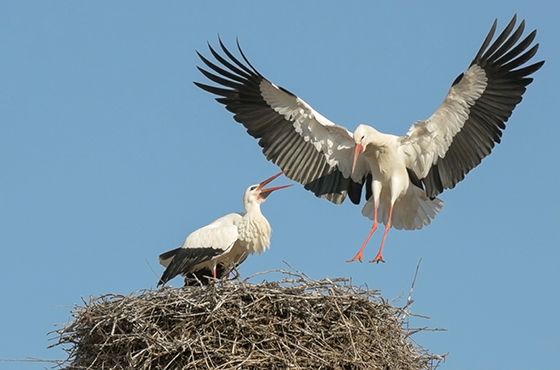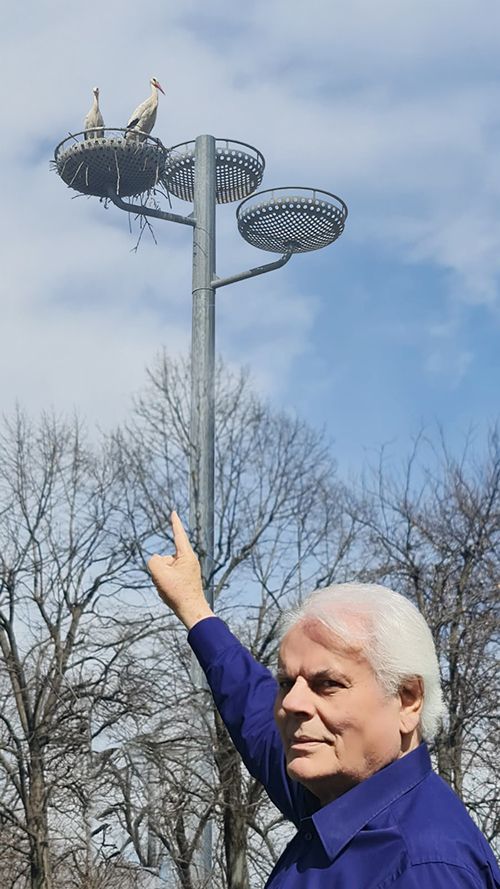Cradle of biodiversity for elegant waders

With their long beaks, slender, stilt-like legs, and two-tone plumage, they have entered the collective imagination as life-bearing birds. Yet spotting storks intent on setting up their distinctive nests suspended at high altitudes, listening to their calls and their beak-flapping courtship always arouses great excitement.
For the past few years, these majestic animals have become an integral part of the fauna that populates the Bassano area, and credit goes to the RAASM Oasis-Park in San Zeno di Cassola. Thanks to the passion to the constant commitment of Giovanni Menon, owner, founder and administrator of the engineering company from which the park takes its name, the area can boast of a great botanical site that has made biodiversity a guideline to follow. Here, for more than thirty-five years, white storks or European storks, of the genus and species Ciconia ciconia, have been hosted along with many other animals, becoming the symbol of the company itself and generating a colony that has become sedentary, despite the migratory nature of the species.
It is, therefore, not too extraordinary an event to lift one’s gaze and cross the sinuous silhouettes of these birds, a species that had become extinct in Italy as nesters by the late 19th century.

A story of love and respect
After purchasing in France, with proper permission, what were the progenitors of the colony in San Zeno di Cassola, the entrepreneur put at their disposal a large aviary in the park, later expanded to 1,000 square meters in area, where the first specimens stayed for about two years before being released. The surprise was great when, instead of flying away, the birds chose the RAASM Oasis-Park as their home, to breed. Since then, white stork breeding has become a reality and has not stopped, increasing annually.
Even today, the miracle of nature is repeated in the large aviary, which houses young storks until they are about two years old, the time it takes for the fascinating birds to become accustomed to the microclimate and the territory, electing it as their natural environment, in which they soar once they are independent. A habitat that allows them to forage for food, aggregate together with others and even nest within the company’s nature oasis, giving rise to their permanent presence, also attracting free-roaming storks.
The circle of life
A true circle of life that continues to renew itself. So much so that, last year, as many as eleven active white stork nests were surveyed within the park, with a total of thirteen storks observed in seven nests. Record numbers, if one considers that this is half of the “birthing rooms” of these wonderful waders in the Veneto Region.
The credit for this is certainly not by chance, but rather by the tremendous care taken by those who strongly desired the creation of the site, maintaining the favorable conditions prepared for them. Such as majestic trees planted in more than twelve hectares of greenery surrounding the farm, pylons erected to house nests, a network of cameras installed to monitor, protect and study the storks, as well as special and capacious feeders for stork birds, fed daily, so as to accustom young individuals to the nearby presence of humans, for educational, observation and study purposes.
From migratory to sedentary species
Thus, thanks to the favorable habitat for nesting, feeding and doing the characteristic “group life,” what would be a migratory species has formed a permanent colony, with a “certificate of residence” and fixed abode in San Zeno di Cassola and the surrounding area.
It is not certain, however, that younger specimens, attracted by wild individuals in transit to African wintering grounds, will not follow the instinct to join flocks, returning to the extraordinary world of migratory birds.
In their beaks they carry infants
Storks are symbolic of the love between parents and children because of their strong family ties and dedication to watching over the nest. Not for nothing do legends tell of them as harbingers of new births. But there is also a real motivation: storks are attracted to warmth, and when the hearth was lit in homes to keep a newborn warm, the majestic birds would build their nests on the chimney. It is the babies, then, who bring the stork!
White stork identity card
|
Name and species
|
White stork, Ciconia ciconia, also known as European stork.
|
|
Appearance
|
Snow-white plumage of the body on which the wing feathers of a glossy black color stand out. The adult specimen shows a bright orange-red hue on legs and beak.
|
|
Size
|
The male is slightly larger than the female: it can reach 115 centimeters in length from beak tip to tail, one meter in height and a wingspan of 155 to 200 centimeters. Weight varies between 3.5 and 4.5 kilograms.
|
|
Sound
|
The stork does not produce an actual song. Adults emit hisses and “coughs” during egg incubation.
|
|
Courtship
|
The male and female assume a peculiar position, throwing back their heads and bringing them forward several times; at the same time, they rapidly beat their beaks, producing a sound similar to castanet percussion.
|
|
Nest
|
Constructed from twigs and sticks, soil, twigs, and blades of grass atop a tree, chimney, or trellis. Older nests can be up to 3 feet in diameter, 2 feet deep and 250 pounds in weight. They can be reused for hundreds of years.
|
|
Reproduction
|
Once a year, the female lays 3 to 6 eggs, hatched in turn by both parents for just over a month. Male and female share duties equally, including feeding the storks and protecting the nest.
|
|
Migration
|
In autumn, storks leave in flocks for warmer lands, where the young will remain until they reach sexual maturity. In spring, the parents return to the nesting site, and the pair stays together for the new season as well.
|
